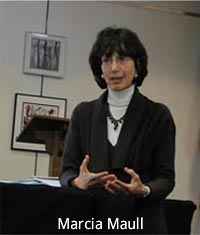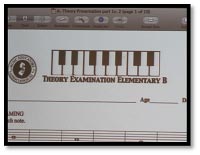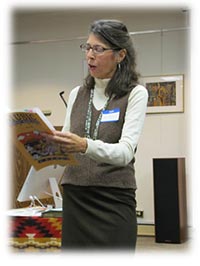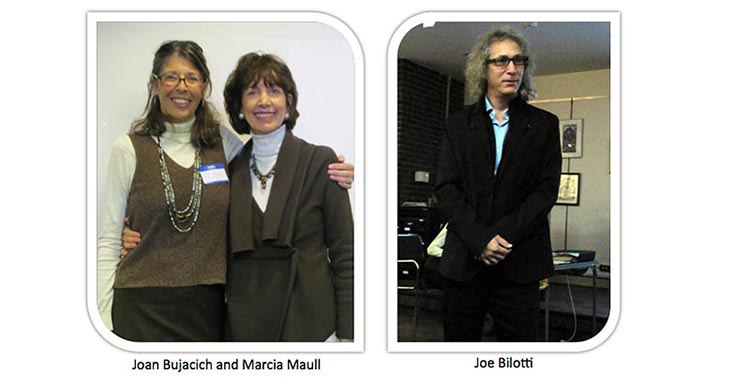Music Educators Association of New Jersey
Serving teachers and students since 1927



At the November General Meeting, Marcia Maull and Joan Bujacich presented the newly updated, revised, and expanded MEA Theory Program, the result of their years of collaboration.
The 2014 edition has an extended syllabus carefully coordinated with MEA Audition achievement levels. Marcia and Joan worked together on a regular basis, inventing and refreshing exercises, and creating new material. Joan did all of the notation work in Finale, a state of the art music notation program, and Marcia, super proofreader and editor, constantly worked on the clarity and presentation of the materials.

 Joan gave a brief history of the theory exams. She recalled attending planning meetings in the late 1970's and early 1980's with the original theory committee. Comprised of past presidents Adell Williams and Lillian Hammer, and Board members Betty Ballare, and Nellie Douglas, that committee created the MEA theory program, which included an enormous textbook-like syllabus and all of the theory tests. This original program remained essentially the same until 2011. Theory exams were held the same day as the performance auditions at the audition centers, with the Center Head hiring a proctor to distribute, collect, and sometimes grade the exams. Over the years, Center Heads began to notice problems recurring with administering the theory tests, including inconsistencies in grading, mistakes in assigning tests, and the cost of hiring a proctor for an entire day when only a few students took a test. It was decided that there was too much strain on those students who were taking the exam and performing an audition on the same day, and theory tests were finally moved from Audition venues to teachers' studios in May 2011.
Joan gave a brief history of the theory exams. She recalled attending planning meetings in the late 1970's and early 1980's with the original theory committee. Comprised of past presidents Adell Williams and Lillian Hammer, and Board members Betty Ballare, and Nellie Douglas, that committee created the MEA theory program, which included an enormous textbook-like syllabus and all of the theory tests. This original program remained essentially the same until 2011. Theory exams were held the same day as the performance auditions at the audition centers, with the Center Head hiring a proctor to distribute, collect, and sometimes grade the exams. Over the years, Center Heads began to notice problems recurring with administering the theory tests, including inconsistencies in grading, mistakes in assigning tests, and the cost of hiring a proctor for an entire day when only a few students took a test. It was decided that there was too much strain on those students who were taking the exam and performing an audition on the same day, and theory tests were finally moved from Audition venues to teachers' studios in May 2011.
To standardize the newly decentralized testing, the tasks for Joan and Marcia were to recreate both the exams and the answer keys and to form a grading plan. There was no digital version of the old, original tests, so they started from a blank page to create new exercises and freshen up previous exercises. They also revised the grading system, raising the passing grade from 50% to 70% correct answers. Then they aligned the grades with the audition categories: Grades of 70-79 = Participant; 80-84 = Good; 85-89 = Very Good; 90-94 = Superior; 95-100 = Outstanding. Next they added a Junior C category; Young Artist A and B; and split Senior A/B tests. Since the only difference between Senior D and Senior C playing requirements involves memorization, Joan and Marcia kept the same theory exam for both categories. There are now fifteen theory test levels. The categories correspond to the MEA Annual Piano Auditions syllabus: Elementary B, A; Junior C, B, A; Intermediate C/D, B, A; Pre-Senior A/B/C; Senior C/D, B, A; Young Artist Preparatory B/C, A; Young Artist A/B. All material presented in each level is cumulative from preceding levels, so each student is responsible for all material covered up to and including the test he or she is taking.
 Theory certificates are given to all participants. After passing three tests, a student will be awarded a blue ribbon; after passing five tests, a student will be awarded a red ribbon. Eventually, seven and ten year test awards will also be implemented. Along with performance requirements, in 2013 MEA offered the new option of applying a theory grade of 90 or higher on a Senior level exam or higher towards the college scholarship requirements and a grade of 90 or higher on an Intermediate exam or higher for a Camp scholarship.
Theory certificates are given to all participants. After passing three tests, a student will be awarded a blue ribbon; after passing five tests, a student will be awarded a red ribbon. Eventually, seven and ten year test awards will also be implemented. Along with performance requirements, in 2013 MEA offered the new option of applying a theory grade of 90 or higher on a Senior level exam or higher towards the college scholarship requirements and a grade of 90 or higher on an Intermediate exam or higher for a Camp scholarship.
October and March registrations in the MEA theory program are open to all MEA member teachers, and students may take the tests at any time. There is no limit to the number of tests a student may take. The theory program is independent of Audition levels. Teachers may prepare students at their own rate and students may repeat a grade in order to get a grade of 70 or above... Note that the theory committee will not always send an identical test. The fee for each exam is five dollars.
 Joan projected on screen a sampling of theory exam papers, beginning with Elementary B level. All exams are organized in the order of each category's list in the Syllabus.
Joan projected on screen a sampling of theory exam papers, beginning with Elementary B level. All exams are organized in the order of each category's list in the Syllabus.
Pentascales (Elementary B, A and Junior C); Major Scales (Junior B and A); Major and Minor scales (Intermediate C/D, B, A, Pre-Senior A/B/C, Senior C/D, B, A) are listed at the beginning of each level. Then various rhythmic requirements: notes, rests, meters are listed, and the specified scales and rhythms will apply to all exercises on that test.
Roman Numerals begin, with the same or related topics appearing in order on each exam:
Students may use whichever version they are taught in their instruction for abbreviations and symbols, such as augmented = aug., Aug., +, etc. They do not need to use the exact nomenclature given on the test answer keys.
How can teachers integrate theory into their studios? They may form extra classes, perhaps three classes every six weeks to study theory. A student could come early before his lesson or stay late to take a test covering one page of the exam.

 Those who attended the lecture were given a handout sheet highlighting theory workbooks for students and for teachers, a music history workbook, and theory software games. Also recommended were the Ear Training YouTube chats that explain one aspect of music at a time, offered by the Discovery Orchestra artistic director, George Marriner Maull, (do a Google search on "Discovery Chat Index").
Those who attended the lecture were given a handout sheet highlighting theory workbooks for students and for teachers, a music history workbook, and theory software games. Also recommended were the Ear Training YouTube chats that explain one aspect of music at a time, offered by the Discovery Orchestra artistic director, George Marriner Maull, (do a Google search on "Discovery Chat Index").
This theory update project took Joan and Marcia two and a half years to complete and was an enormous, painstaking task. We thank them and their advisor, Joseph Bilotti, associate professor of music at The County College of Morris, for laboring over the clarity of concepts in the MEA theory syllabus and testing program. Vicky Griswold shared her library of theory materials with Joan and Marcia at her Plainfield Music Store. Selections were on display at the meeting.

For more information about registering, administering the tests, the theory awards program, and to view the syllabus on-line, please go to the MEA website at www.mea-nj.org, select "For Students", then select "Theory". If you have questions, email theory@mea-nj.org.
Beverly Shea, Hostess and writer